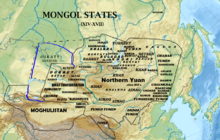Khoshut
This article has multiple issues. Please help improve it or discuss these issues on the talk page. (Learn how and when to remove these messages)
|
 | |
| Regions with significant populations | |
|---|---|
| Languages | |
| Oirat dialect | |
| Religion | |
| Tibetan Buddhism, Mongolian shamanism | |
| Related ethnic groups | |
| Mongols, especially Oirats |
The Khoshut (Mongolian: Хошууд,ᠬᠤᠱᠤᠳ, qoşūd, Chinese: 和碩特; literally "bannermen," from Middle Mongolian qosighu "flag, banner") are one of the four major tribes of the Oirat people. Originally, Khoshuuds were one of the Khorchin tribes in southeastern Mongolia, but in the mid-15th century they migrated to western Mongolia to become an ally of Oirats to counter central Mongolian military power. Their ruling family Galwas was the Hasarid-Khorchins who were deported by the Western Mongols.
The Khoshuts first appeared in the 1580s and by the 1620s were the most powerful Oirat tribe, led others in the Buddhism conversion. In 1636 Güshi Khan led many Khoshuds to occupy Kokenuur (Qinghai), and he was enthroned as king of Tibet by the 5th Dalai Lama (see also Upper Mongols). The Khoshut Khanate was established in 1642. Some time after 1645, his brother Kondeleng Ubashi migrated to the Volga, joining the Kalmyks. However, many Khoshuts remained in the Oirat homeland Dzungaria under Ochirtu Setsen.
After the Dzungar leader Galdan Boshogtu Khan killed Ochirtu, the Khoshut chief Khoroli submitted to the Qing dynasty with his people in 1686 and resettled in Alashan. They numbered 36,900 in 1990.
The Khoshuts of the Dzungar Khanate remained influential until the Qing annihilated them in 1755. In 1771 the Volga Khoshuts fled back to Dzungaria with the Kalmyks and were resettled by the Qing around Bosten Lake. They numbered more than 12,000 in 1999. Their small remnants under a Tumen family in Kalmykia were influential until 1917. Another part of them was formed into a separate banner in Bulgan Province, Khovd Province; but they were counted as Torghut who migrated with them in much larger numbers.
See also
- Lha-bzang Khan, Khoshut chief and King of Tibet
References
- Санчиров В. П. О Происхождении этнонима торгут и народа, носившего это название // Монголо-бурятские этнонимы: cб. ст. — Улан-Удэ: БНЦ СО РАН, 1996. C. 31—50. - in Russian
- Ovtchinnikova O., Druzina E., Galushkin S., Spitsyn V., Ovtchinnikov I. An Azian-specific 9-bp deletion in region V of mitochondrial DNA is found in Europe // Medizinische Genetic. 9 Tahrestagung der Gesellschaft für Humangenetik, 1997, p. 85.
- Haines, R Spencer (2018). "Charismatic Authority in Context: An Explanation of Guushi Khan's Swift Rise to Power in the Early 17th Century". Mongolica: An International Journal of Mongolian Studies. 52. International Association of Mongolists: 24–31.
- Galushkin S.K., Spitsyn V.A., Crawford M.H. Genetic Structure of Mongolic-speaking Kalmyks // Human Biology, December 2001, v.73, no. 6, pp. 823–834.
- Хойт С.К. Генетическая структура европейских ойратских групп по локусам ABO, RH, HP, TF, GC, ACP1, PGM1, ESD, GLO1, SOD-A // Проблемы этнической истории и культуры тюрко-монгольских народов. Сборник научных трудов. Вып. I. Элиста: КИГИ РАН, 2009. с. 146-183. - in Russian
- [hamagmongol.narod.ru/library/khoyt_2008_r.htm Хойт С.К. Антропологические характеристики калмыков по данным исследователей XVIII-XIX вв. // Вестник Прикаспия: археология, история, этнография. No. 1. Элиста: Изд-во КГУ, 2008. с. 220-243.]
- Хойт С.К. Кереиты в этногенезе народов Евразии: историография проблемы. Элиста: Изд-во КГУ, 2008. – 82 с. ISBN 978-5-91458-044-2 (Khoyt S.K. Kereits in enthnogenesis of peoples of Eurasia: historiography of the problem. Elista: Kalmyk State University Press, 2008. – 82 p. (in Russian))
- [hamagmongol.narod.ru/library/khoyt_2012_r.htm Хойт С.К. Калмыки в работах антропологов первой половины XX вв. // Вестник Прикаспия: археология, история, этнография. No. 3, 2012. с. 215-245.]
- Boris Malyarchuk, Miroslava Derenko, Galina Denisova, Sanj Khoyt, Marcin Wozniak, Tomasz Grzybowski and Ilya Zakharov Y-chromosome diversity in the Kalmyks at theethnical and tribal levels // Journal of Human Genetics (2013), 1–8.
- Хойт С.К. Этническая история ойратских групп. Элиста, 2015. 199 с. (Khoyt S.K. Ethnic history of oyirad groups. Elista, 2015. 199 p. in Russian)
- video about khoshuuds
- Хойт С.К. Данные фольклора для изучения путей этногенеза ойратских групп // Международная научная конференция «Сетевое востоковедение: образование, наука, культура», 7-10 декабря 2017 г.: материалы. Элиста: Изд-во Калм. ун-та, 2017. с. 286-289. (in Russian)
